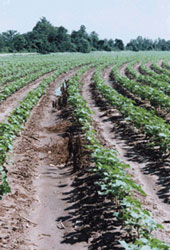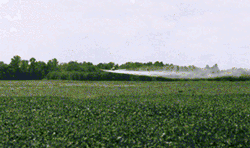
Herbicide-Tolerance
Herbicides are chemicals that kill plants. Herbicide-tolerance in plants permits greater amounts of herbicides to be applied without harming the crop, exceeding currently lethal doses. Any plant can theoretically be engineered for tolerance, though currently corn, potato, tomato, and soybean crops have been the ideal targets. By offering crops tolerant to herbicides, chemical companies can broaden the market for their products. In fact, the major developers of herbicide-tolerant plants are seed and pesticide companies, such as Novartis and Monsanto. The current set of commercially available herbicide-tolerant crops is tolerant to three herbicides based on three active ingredients: bromoxynil, glyphosate, and glufosinate (Union of Concerned Scientists, 1998).
Case-Study: Roundup Ready Soybeans
Widespread use of a major crop with tolerance to a particular herbicide would significantly increase sales of that herbicide and the corresponding seed package (see terminator seeds). The herbicide Roundup, produced by Monsanto, currently generates about 40 percent of the company's annual revenue (Union of Concerned Scientists, 1998). Since its commercial introduction in 1996, over one-third of U.S. soybean acreage have been planted with Roundup Ready varieties (Benbrook, 1999). The projected planting of perhaps 12 million acres of Roundup ReadyTM soybeans will substantially increase Monsanto's revenues as farmers switch from their current herbicide to Roundup.
Potential Environmental Risks
Herbicides contaminate groundwater, farm and forest land. They likewise destroy wildlife habitat and are associated with wild animal and human disease. Manufacturers claim that herbicide-tolerant varieties will result in decreased dependence on environmentally nocuous herbicides like atrazine, whose active ingredients persist in the environment. However, Glyphosate, the active ingredient in the herbicide Roundup, is highly toxic to plants and fish. In addition, many preparations of glyphosate are dissolved in so-called inert ingredients that can also be toxic.
Emergence of Tolerant and/or Resistant Weeds
Besides the impact of annual applications of Roundup on over 12 million acres of U.S. soil, the use of glyphosate-tolerant soybeans poses additional environmental risks. Herbicide-tolerant crops can transfer their tolerance trait to nearby related plants and weeds. The use of glyphosate on millions of acres in the United States will intensify the selection pressure for resistance in weeds unrelated to the targeted soybean crop. As weeds become resistant to the herbicide, farmers will have to increase both amount and number of applications, accelerating the downward spiral toward the loss of glyphosate as a weed-control tool. In addition, the glyphosate-tolerant plants could have effects on soil ecology that have not been assessed.
The use of genetic engineering to produce new combinations of traits may enable the target crop to thrive in previously uninhabitable environments, thereby producing circumstances where they would then be considered new or worse weeds. In addition, widespread use of herbicide-tolerant crops could facilitate the evolution of resistance to herbicides in weeds, either as a result of increased exposure to the herbicide or as a result of the transfer of the herbicide trait to weedy relatives of crops.




